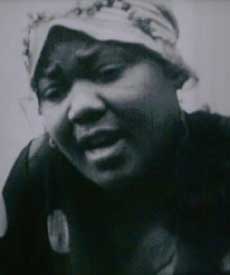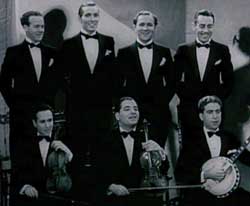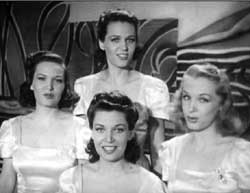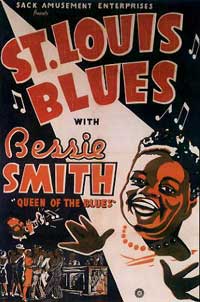Bessie Smith starred in only one film, the Paramount musical short St. Louis Blues (1929), which frames her best known song in a very little drama. Although uncredited, the film's dramatic outline was written by Kenneth W. Adams & W(illiam) C(hristopher) Handy, the latter having written the title song in 1924. The story has considerable shortcomings, but for once these can't be blamed on white writers trying to capture black experience; Handy, one of the greatest jazzmen of his age, was black as they come.
 Bessie's appearance is held off while we observe gambling going on in the hallway. Dandified "Jimmy the Pimp" (Jimmy Mordecai) shows up with his girlfriend (Isabel Washington Powell), who gives him good luck throwing the dice, & he cleans up with a single throw. Bessie's appearance is held off while we observe gambling going on in the hallway. Dandified "Jimmy the Pimp" (Jimmy Mordecai) shows up with his girlfriend (Isabel Washington Powell), who gives him good luck throwing the dice, & he cleans up with a single throw.
Having reason to believe Bessie won't be home for some while, Jimmy takes his girlfriend up to Bessie's room for some pleasure time. But she catches them together, gives the hussy a thrashing, & throws her out.
Jimmy didn't have the gumption to keep Bessie from beating his new girl, but when she's alone with him & begging him not to leave her, it's pretty easy for him to knock her on the ground & before he walks out.
For a mere two-reel film it manages to find plenty of time to convey how black men are shiftless gamblers & thieving horndogs & pimps, but the nasty stereotyping is just about forgiveable for the chance to see Bessie singing, 'My man's got a heart like a rock that's in the sea."
The scene shifts to a cafe as she sings "St. Louis Blues" with the cafe patrons backing her up as a chorus. Those patrons are in fact the Hall Johnson Choir, who also sang for Disney's 1946 Song of the South, & did the crows' song "When I See an Elephant Fly" from Dumbo, 1949).
Bessie had been unable to show any acting ability with the terrible material given to her to act. But when she sings, she is full of actorly conviction of sadness.
This is a very early sound film & microphones had to be hidden near people's faces. Bessie's is hidden on the bar, so for just about the whole song she is bent over the bar singing into the mic. She manages to make it look like a posture of misery & woe, but it's strange that we as viewers are treated mostly to camera shots of her backside.
When she finishes the song, the band strikes up a hot jazz instrumental & the room comes alive with life. Though uncredited, the orchestra is that of James P. Johnson, who is at the piano. Johnson devised an intermediate piano style halfway between ragtime & swing jazz, which became known as Stride.
Bessie leaning on the bar is unable to enjoy any of it. Jimmy unexpectedly saunters in & the dance floor gives way to his amazing tapdancing.
He then spots Bessie & they're back together quick as that, or so she believes. She's so happy to be dancing in Jimmy's arms again. He treats her well until he gets his hands on the money she has on her, & then he's out of there like a gunshot, leaving Bessie to reprise her sad, sad song.
 The Vincent Lopez Orchestra stars in the Paramount musical short Those Blues (1932) in which, unfortunately, Lopez conveys all the conducting charisma of an old shoe.
The Vincent Lopez Orchestra stars in the Paramount musical short Those Blues (1932) in which, unfortunately, Lopez conveys all the conducting charisma of an old shoe.
We're treated or maltreated to a "medium band version" (there being too few band members to quality as a Big Band) of "St. Louis Blues," entirely gutted of emotion.
With penny whistle accompaniment, the great blues song is reduced to a whimsical novelty tune. A chorus of white guys, one holding a banjo mostly as a decoration, make it all very jolly & happy sounding.
Watching this awful little performance back-to-back with Bessie Smith's St. Louis Blues was an object lesson on white confiscation of black blues classics. And I'm sure as hell not surprised scarcely a soul remembers the Vincent Lopez Orchestra, not even with Vincent's son reviving the band name for updated humiliation.
 Alvino Rey & His Orchestra start off the three-minute soundie St. Louis Blues (1941) very promisingly with lots of brass. I almost thought this was going to be a reasonably good soundie.
Alvino Rey & His Orchestra start off the three-minute soundie St. Louis Blues (1941) very promisingly with lots of brass. I almost thought this was going to be a reasonably good soundie.
But then four lousy girl singers, the lamentable King Sisters, appear specifically to butcher this blues classic.
The sisters seem to think they're singing it in the Little Brown Church in the Dell to an audience of alzheimer victims. Three of the sisters provide "doo doo doo doo" backup & doodoo is exactly what it is. When they begin to harmonize all four together it's about half tolerable, like Andrew Sisters just getting over bad colds.
At the instrumental break, add a slide guitar solo -- the one great thing seen here -- & it's odd to discover how close a blues number can come to western swing.
The musician on slide is Alvino himself, & he's great until that probably unintentionally comedic moment when gets some "wah wahs" out of it that are supposed to sound like a blues wail I suppose, but sound like a Crybaby Doll, squeeze it & it cries, shake it & it gets shaken baby syndrom. Still, if he could've ditched the King Sisters he'd've had a nice little soundie.
copyright © by Paghat the Ratgirl
|

 Bessie's appearance is held off while we observe gambling going on in the hallway. Dandified "Jimmy the Pimp" (Jimmy Mordecai) shows up with his girlfriend (Isabel Washington Powell), who gives him good luck throwing the dice, & he cleans up with a single throw.
Bessie's appearance is held off while we observe gambling going on in the hallway. Dandified "Jimmy the Pimp" (Jimmy Mordecai) shows up with his girlfriend (Isabel Washington Powell), who gives him good luck throwing the dice, & he cleans up with a single throw.
